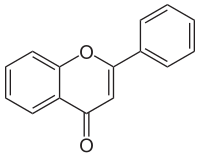
Photo from wikipedia
As a typical kind of bioactive flavonoid glycoside, rutin and its aglycone quercetin possess similar chemical structures and properties. It still remains a challenge to achieve reliably and accurately detection… Click to show full abstract
As a typical kind of bioactive flavonoid glycoside, rutin and its aglycone quercetin possess similar chemical structures and properties. It still remains a challenge to achieve reliably and accurately detection of rutin in the presence of quercetin. In this work, a simple fluorescent method combining water-dispersed silicon nanoparticles (SiNPs) with bovine serum albumin (BSA) were constructed for the selective detection of rutin in the presence of quercetin and other common compounds in traditional Chinese herbs. SiNPs with high fluorescent quantum yield and good thermostability were prepared by one-pot hydrothermal method using ferulic acid as the reduction reagent for the first time. The fluorescence of SiNPs could be obviously quenched both by rutin and quercetin in phosphate buffer solution. Interestingly, when the solution contained certain concentration of BSA, the fluorescence of the SiNPs can only be remarkably quenched by rutin. The innovative use of BSA to block the interference of quercetin make it possible to selectively detect of rutin by fluorescence spectrometry under the coexistence of quercetin. Under the optimum conditions, the fluorescence displayed a linear decrease response as the rutin concentration increased in the range of 0.33-33.30 μM with a detection limit of 0.04 μM (S/N = 3). The possible quenching mechanism of rutin to SiNPs has also explored and concluded to be mainly caused by inner filter effect. This work provides a novel methodology for the simple, low-cost and selective determination method for rutin.
Journal Title: Analytica chimica acta
Year Published: 2020
Link to full text (if available)
Share on Social Media: Sign Up to like & get
recommendations!